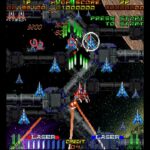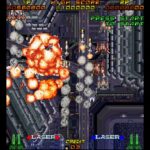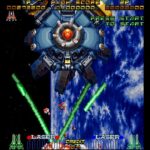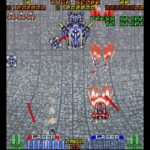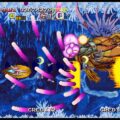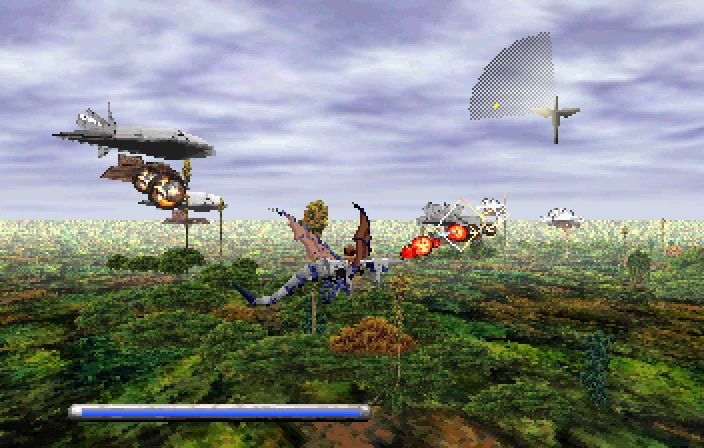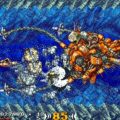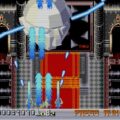Developer: Taito Released: Acclaim Released: 1995 Genre: Shooter
I’ve made fun of the deluge of shooters during the 16-bit era in the arcade and at home. But I do it out of love. That being said I genuinely missed the genre when it all but became import exclusive with the release of the PlayStation and Saturn. Sure, occasionally Square Enix and Working Designs would release a gem. But the very best were all but destined to become expensive imports. The pickings were slim in the US but at least we got some cool titles. Taito had already proven themselves as masters of the genre with Space Invaders, Darius, and Operation Wolf. But they would add another notch in their belt with the Ray series. Acclaim surprisingly released Taito’s Rayforce as Galactic Attack and we benefited. This is an extremely cool hidden gem and the start of a great series.
In the distant future mankind entrusts its future to the Supercomputer Con-Human. Things go horribly wrong when a cloned human links with Con-Human and causes it to become sentient and insane. Its first course of action is to nearly wipe out humanity, leaving the remnants to settle in space colonies. The remaining humans plan to stage one last assault against Con-Human who has now transformed the entire planet into one global attack fortress.
Galactic Attack/Rayforce was among many mid 90s shooters that brought innovative ideas to the genre. As a 1993 arcade release it doesn’t use 3d but simulates depth using 2d and parallax scrolling. This is not just for show as it affects gameplay as well. Galactic Attack is similar to Twinbee and Legendary Wings in that you deal with airborne and ground based enemies simultaneously. In this case however Galactic Attack does it with at another level.
Your ship has homing lasers and a targeting reticle. Technically you can fire homing lasers at random. But if you aren’t lock-on to a target they hit nothing. You cannot control the reticle separately and it remains at a fixed distance from your ship. This means positioning is key, especially when dealing with multiple targets. It sounds simple but the way the game makes use of this feature is what makes Galactic Attack great. The only other weapon is your standard forward facing laser. Collecting three yellow crystals will advance it one level while red crystals grant one level alone. They also increase how many targets you can lock-on, up to a maximum of eight. It is an incredibly light system but in practice they are all you need.
The gameplay loop of Galactic Attack is simple but incredibly satisfying. Dealing with ground air based enemies simultaneously is nothing new. But the way it is handled here is why the game is so great. Galactic Attack plays around with multiple layers at all times, sometimes going three or four layers deep. Seeing distant targets below and trying to lock-on before they ascend and add to the chaos is a game in itself. The decision to keep your targeting reticle at a fixed distance is stroke of genius in my opinion as it forces you to place yourself in danger constantly to be effective. It sounds like a formula that would become repetitive in short the game’s various scenarios stave that of. Although it is a short journey Galactic Attack is a memorable one.
The difficulty has a smooth pace that I like, at least until its final two levels. Initially the action only occurs on two planes and enemy waves are measured. By stage four and five that number becomes four as you fly through the enemy base and a multi-layered city. Enemies appear in groups of twenty and it becomes a matter of managing the chaos. Despite the bosses being massive damage sponges the game still remains fair. The difficulty goes through the roof in the final two levels as the game descends into the kind of bullet spraying madness that turn many away from the genre. The final battle in particular will drive you insane. Prepare to see the generous four credits disappear quickly. Galactic Attack is so good that you will come back for more however.
Galactic Attack saw a release prior to 3d becoming the industry standard for gaming. As such it uses sprites and scaling to simulate depth. This technique Is used to great effect; the layers of scrolling can go five layers deep at times. Watching activity unfold on multiple planes is still impressive today although the game shows its age a bit. One touch that I especially like, the game is one continuous journey, from the atmosphere above the planet down to its core. It never fades away or has a typical level break. Once a boss is defeated your score is tallied, the name of the next level is displayed and it continues. Very cool.
In Closing
Galactic Attack is a phenomenal game and one of the Saturn’s best shooters. That says a lot considering its legendary library in the genre. Great graphics, polished, gameplay, and a high yet fair challenge make Galactic Attack a no brainer for anyone slightly interested in the genre.


